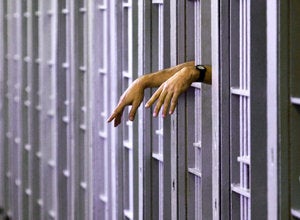The official unemployment figure of 9.6 percent is, according to a new report, "unrealistically rosy" because it doesn't account for a full 2.3 million Americans -- those serving time.
And not only that: When formerly incarcerated men find work after prison, their annual earnings are 40 percent lower than if they had never been behind bars, and their prospects for upward mobility are significantly bleaker, according to a new study by the Pew Charitable Trusts (hat tip to Mike Konczal).
The report, authored by Bruce Western and Becky Pettit, which investigates the relationship between incarceration and economic mobility, concludes that the vast amount of resources dedicated to incarceration amount to a significant drain on the nation's economy. Currently more than one in 100 Americans is in prison, the report says, as the total incarcerated population, at 2.3 million, is by the far the world's largest. The U.S. prison population, in fact, is larger than that of the top 35 European countries combined. What's more, the U.S. spends about $50 billion annually to maintain this system.
Among men, and especially non-white men, the proportion of inmates is particularly high:
- For men of working age (18 to 64 years old), 1.1 of the white population is in prison, compared to 2.7 of the Hispanic population and 8 percent of the black population.
For young men (aged 20 to 34), 1.8 percent of whites are incarcerated, compared to 3.7 percent of Hispanics and 11.4 percent of blacks. For that same age group without a high school degree, 12 percent of whites, 7 percent of Hispanics and 37.1 percent of blacks are behind bars.Former inmates earn significantly less after prison than if they had never served time, the study found. White men earn 52 percent less after serving time; Hispanic men earn 41 percent less and black men earn 44 percent less. Considering these losses in a larger context, the investigation found that total wages earned by all white men are 2 percent lower than they would be if the incarcerated population weren't incarcerated, compared to a 6 percent reduction for Hispanics and a 9 percent reduction for blacks.
The nation's headline unemployment rate has been stuck at around 9.6 percent for months. If U.S. GDP growth remains lackluster, economists predict unemployment will rise to 10.1 percent in 2011.
But, the report says, those figures don't account for the incarcerated population. "With more than 2.3 million adults incarcerated," the report says, "the effect of this omission has become too substantial to ignore."
The report likens the official survey method for unemployment to a school that assesses student health but omits all the students who were at home, sick.
Read the report, with helpful charts, below:
Support HuffPost
Our 2024 Coverage Needs You
Your Loyalty Means The World To Us
At HuffPost, we believe that everyone needs high-quality journalism, but we understand that not everyone can afford to pay for expensive news subscriptions. That is why we are committed to providing deeply reported, carefully fact-checked news that is freely accessible to everyone.
Whether you come to HuffPost for updates on the 2024 presidential race, hard-hitting investigations into critical issues facing our country today, or trending stories that make you laugh, we appreciate you. The truth is, news costs money to produce, and we are proud that we have never put our stories behind an expensive paywall.
Would you join us to help keep our stories free for all? Your contribution of as little as $2 will go a long way.
Can't afford to donate? Support HuffPost by creating a free account and log in while you read.
As Americans head to the polls in 2024, the very future of our country is at stake. At HuffPost, we believe that a free press is critical to creating well-informed voters. That's why our journalism is free for everyone, even though other newsrooms retreat behind expensive paywalls.
Our journalists will continue to cover the twists and turns during this historic presidential election. With your help, we'll bring you hard-hitting investigations, well-researched analysis and timely takes you can't find elsewhere. Reporting in this current political climate is a responsibility we do not take lightly, and we thank you for your support.
Contribute as little as $2 to keep our news free for all.
Can't afford to donate? Support HuffPost by creating a free account and log in while you read.
Dear HuffPost Reader
Thank you for your past contribution to HuffPost. We are sincerely grateful for readers like you who help us ensure that we can keep our journalism free for everyone.
The stakes are high this year, and our 2024 coverage could use continued support. Would you consider becoming a regular HuffPost contributor?
Dear HuffPost Reader
Thank you for your past contribution to HuffPost. We are sincerely grateful for readers like you who help us ensure that we can keep our journalism free for everyone.
The stakes are high this year, and our 2024 coverage could use continued support. If circumstances have changed since you last contributed, we hope you’ll consider contributing to HuffPost once more.
Already contributed? Log in to hide these messages.
